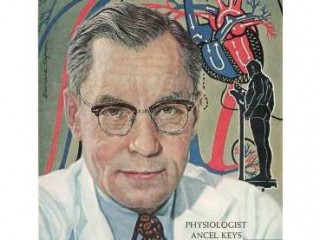
Ancel Keys biography
Date of birth : 1904-01-26
Date of death : 2004-11-20
Birthplace : Colorado, U.S.
Nationality : American
Category : Science and Technology
Last modified : 2011-12-19
Credited as : scientist, Nutritionist, created the K ration
0 votes so far
He examined the epidemiology of cardiovascular disease (CVD) and was responsible for two famous diets: K-rations formulated as balanced meals for combat soldiers in World War II and the Mediterranean diet, which, with his wife Margaret, he popularized. Science, diet, and health were central themes in his professional and private lives.
While doing fish research at Scripps, Keys would use regressions to determine the weight of fish from their length, a pioneering use of biostatistics at the time. Once in Copenhagen (1931), he would continue to study fish physiology and developed techniques for gill perfusion that provided evidence that fish regulated their sodium by controlling chloride excretion through their gills.
He would also use this perfusion method to study the effects of adrenaline and pitressin on gill fluid flow and osmotic regulation in fishes. He also designed an improved Kjeldahl apparatus which improved upon Krogh's earlier design and allowed for more rapid determination of nitrogen content in biological samples. This would prove useful for activities as diverse as determining the protein content in grasshopper eggs and anemia in humans.
While at Harvard's Fatigue Laboratory, he was inspired by his Cambridge mentor John Barcroft's ascent to the top of Tenerife's highest peak and his subsequent reports. Keys wrote up a proposal for an expedition to the Andes suggesting the study could have practical value for Chilean miners that worked at high altitudes.He was given the go-ahead and in 1935, assembled a team to study the effects of high altitude on the body such as how it affects blood pressure. He spent a couple of months at 9,500 feet and then 5 weeks at altitudes of 15,000 to 20,000 feet.
He noted that there was no good way of predicting how well humans might adapt to high altitude, even if they adapted well to medium altitudes, which would be a problem for potential pilots in a time before pressure control. It was from these studies that he outlined the phenomenon of human physiological adaptation to environmental changes as a predictable event; a novel idea in a time when such things as blood pressure and resting heart rate were considered immutable.
During World War II, Keys produced various studies related to human physical performance that were of interest to the military such as studying the effects of testosterone on muscle work, and vitamin supplementation as a performance enhancer on adequately fed soldiers among many other similar studies. It was during the war that Keys and fellow researchers recognized the importance of knowing how to properly treat the widespread starvation since simple overfeeding for so many would be imprecise and there was a potential that the refeeding would fail.
To gain insight into the physiology of starvation, in 1944, Keys carried out a starvation study with 36 conscientious objectors from Civilian Public Service as test subjects in the Minnesota Starvation Experiment. At the time, conscientious objectors were being placed in virtual concentration camps with a few functioning like the Civilian Public Service so that recruiting them would prove easier than seeking out volunteers in the general population. The original pool of 400 responders was reduced to 36 selectees, of whom 32 would go on to complete the study.
The main focus of the study was threefold: set a metabolic baseline for 3 months, study the physical and mental effects of starvation on the volunteers for 6 months and then study the physical and mental effects of different refeeding protocols on them for 3 months.The participants would first be placed on the 3 month baseline diet of 3200 calories after which their calories were reduced to 1800 calories/day while expending 3009 calories in activities such as walking. The final 3 months were a refeeding period where the volunteers were divided into 4 different groups.
The war came to an end before the final results of the study could be published, but Keys sent his findings to various international relief agencies throughout Europe and by 1950, he completed publication of his two-volume 1385-page Biology of Human Starvation.However, already in the 1960s Keys was able to convince a sizable part of the US public that replacing saturated by unsaturated fat would reduce blood cholesterol and the incidence of coronary heart disease. The resulting changes in the composition of food fats led to a doubling of the proportion of the unsaturated fatty acid, linoleic acid, in the body fat of Americans between 1960 and 1975 Mortality rate from coronary heart disease in the US began to fall from 1968 onwards, and about half of the decline was ascribed to changes in lifestyle including diet.
Keys also popularized the use of the body mass index (BMI) as a measure of body fat, following a 1972 paper.
Keys was always considered an interventionist. He generally shunned food fads and vigorously promoted the benefits of the "reasonably low-fat diets" he contrasted with "the North American habit for making the stomach the garbage disposal unit for a long list of harmful foods." Keys' studies and recommendations have had a substantial impact on changes in the U.S. diet that may have caused a downward trend in CVD. Several recent studies have vindicated Keys' thesis that unsaturated oils are more effective at improving markers of CVD than high-carbohydrate low-fat foods. Because of his influence in dietary science, Keys was featured on the cover of the January 13, 1961 issue of Time magazine.
Ancel Keys died on November 20, 2004, two months before his 101st birthday. A year earlier, he had left Pioppi, his beloved village in Southern Italy where he had spent 28 years of his life.
















